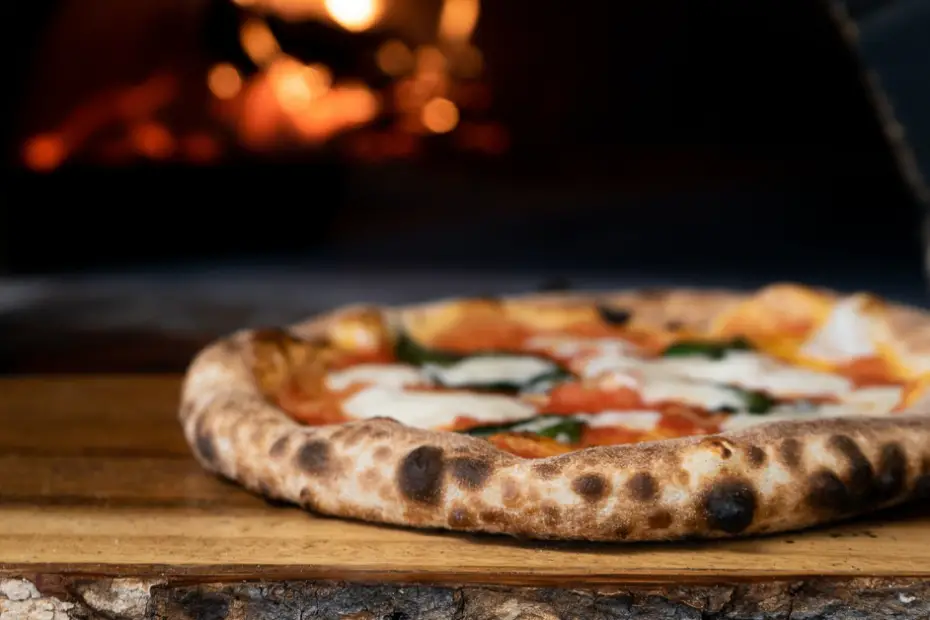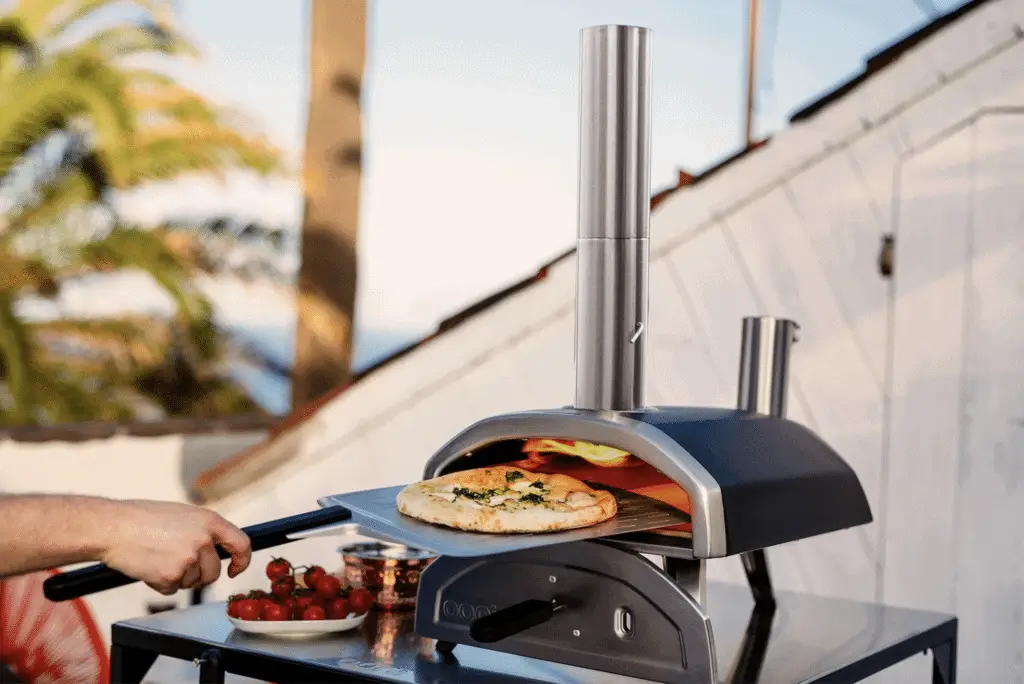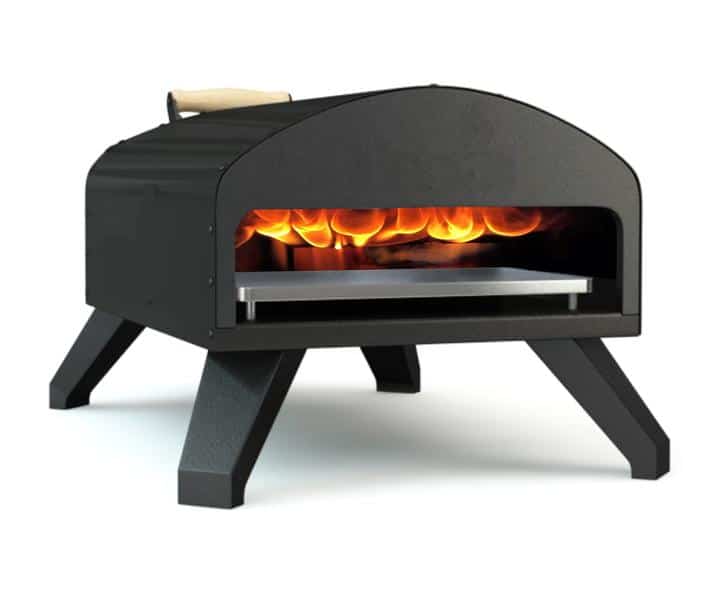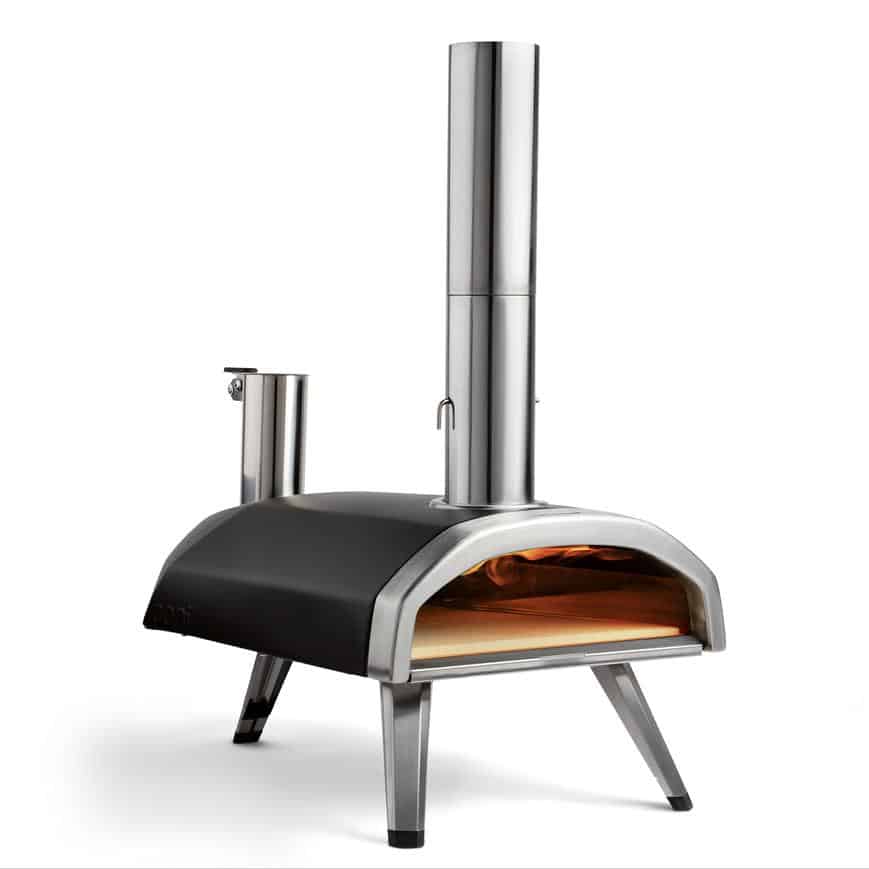Wood pellet pizza ovens are the most sought-after ovens due to their authentic taste. Gas pizza ovens simply can’t compare to the taste of a homemade, wood-fired pizza. Wood-fired pizza is even better when you cook with hardwood pellets instead of wood chunks or logs, a cooking option that can only be accomplished in a wood pellet pizza oven.
There is a learning curve when you’re cooking pizza with wood pellets, though. These ovens often burn at high temperatures due to the wood and the design of the pizza oven. Pizzas cook faster here than a typical wood fired pizza oven, and it will take some practice to learn how to use pellets to heat the cooking surface evenly. Beginners commonly burn the toppings as wood pellets generate higher heat over a traditional pizza stone, which usually only reach 450°F.
It can be worth it to learn how to use these kinds of outdoor pizza ovens, though, especially if you want to enjoy some delicious pizza. This guide here will tell you everything you need to know about wood pellet pizza ovens before you buy.
DISCLOSURE: This post may contain affiliate links, meaning when you click the links and make a purchase, we receive a commission at no extra cost to you.
Why Use a Pizza Oven with Wood Pellets?
Wood pellets are the most convenient of the solid-fuel pizza oven models. A hardwood pellet is composed of compressed sawdust allowing them to quickly ignite and burn at high temperatures. Pellets allow you to cook your meal as soon as they ignite, with no need to wait for the oven to preheat. If you want to enjoy pizza quickly, a wood pellet pizza oven is perfect.
Unfortunately, wood pellet ovens don’t offer truly effortless cooking. There is a learning curve to working with hardwood pellets.
When outdoor cooking with these, you have to watch the wind. Wind will draw the heat up from the firebox, through your oven cavity, then up your chimney. Stiff breezes will stoke your flames and burn the pellets too quickly. This will make the oven too hot, burning your homemade pizza.
Wood pellets are also sensitive to humidity and moisture, which can make them expand and jam your hopper. All wood pellets should be kept in a sealed, dry container with a tight-fitting lid to remain moisture-free.
Things to Consider
Not all wood is created equally. You will need to select the best wood for your oven as the wrong wood can generate a damaged oven, horrible tasting pizza, and clouds of smoke. Your wood should be a hard, well-seasoned wood to generate the best flame.
Each type of wood burns differently in your wood pellet pizza oven. Different types of trees come with different densities. They produce various amounts of sap, scent chemicals, and moisture making them burn slower/faster, cooler/hotter, and generate different smoke levels. The ideal wood should be slow and hot without generating a great deal of smoke.
The things to consider boil down to a difference between softwood/hardwood and whether it is well-seasoned/green.
Green Wood or Seasoned Wood?
It is always best to use well-seasoned dry wood in wood fired pizza ovens. It does take time for the moisture to dissipate from a log- especially ones as dense as hardwood. Seasoned wood goes through a process of allowing extra water to escape prior to it burning.
Greenwood is not good for pizza ovens. It is challenging to light since it is still moist, and if it does ignite, it burns unevenly and generates vast amounts of steam. It may ruin your pizza and/or break the pizza oven, which is a no-go for any pizza lover.
Softwood or Hardwood?
When it comes to your pizza oven, it is best to use hardwoods. Since they come from deciduous trees, they tend to be denser and produce less sap over softwood. This allows them to be heavier leading to a steady, hot, long-lasting burn.
Users should avoid using softwoods in a pizza oven. Pine trees are considered softwoods. They have vast amounts of sticky sap and are lighter than hardwood pellets. Due to the sap they contain, softwood can lead to high amounts of smoke when making a pizza. It also burns quicker and doesn’t generate as much heat.
What Wood Should I Choose?
Now that we have established the reasons for using hardwood in a pizza oven, you need to be aware of which one to choose. The wood affects the taste of the pizza and offers different smells.
Standard Hardwood: This is usually used to fuel a pizza oven. They are easy to locate and burn clean and hot.
Oak: This type of wood is standardly used for log-burning ovens. It isn’t hard to find, burns efficiently and provides high temperatures.
Birch: If you are unable to locate oak, then you should be able to find birchwood. Birchwood doesn’t burn as hot but will generate an even, steady hot temperature. It is clean-burning wood, so it won’t leave much ash behind on your pizza.
Hickory: This wood is often associated with bacon and adds a strong note that compliments pork products. Many types of meat benefit from using hickory, so if you are creating a pizza topped with bacon, pork, or ham, consider using hickory pellets.
Maple: Maple is a flavorful wood that adds a touch of sweetness to food. It is ideal for Hawaiian pizza or anything with pineapple as it complements the fruity flavor.
Pecan: This is stronger than cherrywood, yet not as intense as using mesquite. It will add a bit of a nutty flavor to your pizza.
Apple: This is a favorite among restaurateurs. It will provide a high temperature, so pizzas are cooked quickly.
Cherry: Cherrywood provides a light, sweet flavor with a touch of fruitiness.
Mesquite: This adds a strong, earthy flavor, adding a southwestern feel to any dish. It pairs well with pizzas containing dark or red meat.
When selecting your pellets, make sure they specify the wood. Some can provide a mixture of softwood and hardwood leading to poor cooking results. You should be able to locate hardwood from various types of trees, however, beechwood will be the most common. It will evenly and cleanly burn plus add a smoky flavor to your food.
How Do You Cook a Pizza in a Wood Pellet Pizza Oven?
Operating a wood pellet pizza oven may take some practice. Here are a few tips and instructions to get you started:
- Before you light your oven, remove the chimney cap, then make sure the oven door is on.
- Place a couple of scoops of pellets in the hopper and put them in the back tray of the oven. Insert your torch on the side to ignite the pellets for about 30-60 seconds.
- After five minutes or when properly lit, you can then begin topping up. There is a bolt located at the back and can be used as a guide. Pellets should be topped up to this level.
- You may see some smoke as you begin to burn, but the pellets should burn clean once you’re running at top temperature.
- Top up the pellets when it reaches below the desired level. Too many pellets will decrease airflow. The idea is to maintain consistency while burning as this will create the best pizza.
- Once the pellets are topped up and the oven is burning, take the temperature of the baking stone to see if it’s ready. It should be at 660°F or so depending on your model and the pizza type.
For Cooking:
- Make sure the dough is at room temperature and give a sprinkling of flour or cornstarch to the pizza peel so it will easily remove the pizza dough. If the pizza is stuck, lift the dough gently at one side. Provide a gentle blow of air underneath to help release it.
- Slide the pizza in, then close the door. Turn the pizza after 30 seconds by lifting the door off and sliding the peel in. Give the pizza a 180° turn. Return the pizza to the oven and close your door.
- You will want the chimney to draw the flames upward across the top of the pizza and up the chimney for a perfect cook.
- Rotate the pizza once or twice for an even cook, and you are finished.
If you are cooking another pizza, let the oven rest for one to two minutes to get back up to full heat before putting it in. Check on your pellets to make sure they are topped up.
Dedicated Pellet Ovens
These are smaller pizza ovens that are generally made from stainless steel. This makes them perfect for outdoor use (assuming the material is of good quality) because they are durable, strong, and resist rust and corrosion from the elements. They are also known to retain heat very well and provide an even cooking temperature.
The benefit of these pizza ovens is that they do not require an electrical power source to use them. They are great because they are both portable due to their size, and they can be used anywhere because you don’t need a power source-just pellets.
The Best Pellet Ovens
Bertello Outdoor Pizza Oven
Bertello pizza ovens are not as well-known for their wood pellet ovens but they do make some compact models that run on hardwood pellets. These ovens cook a 12” pizza like the Fyra and have a painted black finish.
The difference with the Bertello is that they can be adapted to fit a gas burner. The Fyra is only a dedicated wood pellet pizza oven.
Pros
Cons
Ooni Fyra 12
Ooni pizza ovens have consistently been a favorite among people who want a great-tasting pizza. They are known for their quality, durability, and sleek design. Ooni’s motto is also that everyone deserves a great pizza.
An Ooni pizza oven can reach temperatures up to 950°F in 15 minutes and can cook a classic Neapolitan style pizza in under a minute.
The Ooni Fyra works by first adding fuel through the hatch then lighting it. From there, the air flows through the vents while the fuel (pellets) burn, generating fire/hot air. The hot air heats the pizza oven. Your food is cooked via radiating heat.
The baking stone also heats up allowing food to be cooked evenly from the bottom. This allows the pizza to obtain a crisp pizza base. Food can be added or removed via the food door.
The body is insulated and retains heat for evenly cooking your toppings while the crust heats. This current goes over the pizza while the baking stone cooks it from underneath. The chimney then draws the heat through the oven and outside.
In this model, your wood pellet fire is found at the rear of the pizza oven. The heat, as mentioned, is pulled over the top of the pizza via the open chimney found at the front of the oven.
Pros
Cons

Hey there, I’m Greg Palmer, and I’m thrilled to share my story with you. Together with my brother Tim, I run the website GoodLifePizzaOvens.com, and it’s been quite the journey!
Our roots run deep in a beautiful countryside where we spent our childhood surrounded by nature’s wonders. Those were the days of horseback rides, fixing fences, rounding up cattle, and the never-ending quest to catch chipmunks raiding the grain barrel. But among all the adventures, that one special summer stands out, etched in our hearts forever—a time we both cherish dearly.



